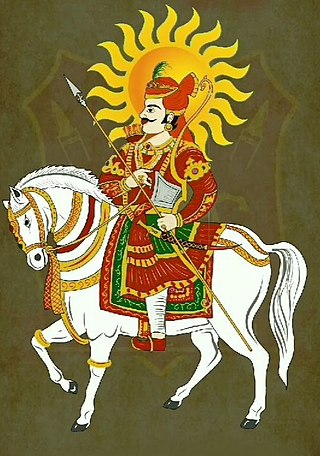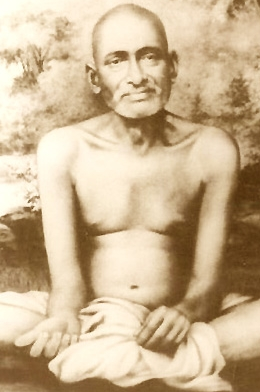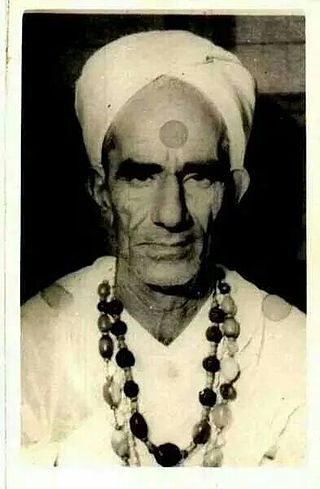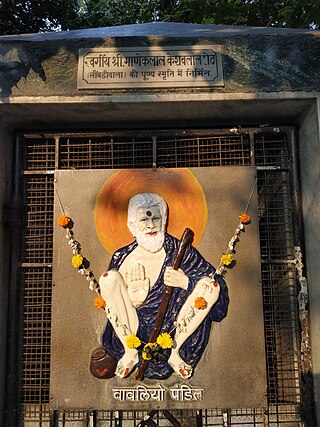
Neem Karoli Baba or Neeb Karori Baba, also known to his followers as 'Maharaj-ji', was a Hindu guru and a devotee of the Hindu deity Hanuman. He is known outside India for being the spiritual master of a number of Americans who travelled to India in the 1960s and 1970s.

Veer Tejaji Jat also known as Tejaji Maharaj, or simply Tejaji, was a great warrior, social reformer and folk-deity of Rajasthan. In rural parts of northern Rajasthan, he is revered as a deity and is considered to be one of Lord Shiva's eleven primary incarnations. He is mainly worshipped in the states of Rajasthan, Madhya Pradesh, Haryana, Uttar Pradesh, and Gujarat. He is commonly known as the God of Snakes in Rajasthan, because it protect against snake bites or also worshipped as Dhauliya Veer.

Gajanan Maharaj was an Indian Hindu guru, saint and mystic. His origins remain uncertain. He first appeared at Shegaon, a village in Buldhana district, Maharashtra, as a young man aged 30, probably on 23 February 1878. He attained Sanjeevana Samadhi on 8 September 1910, which is thought to be a process of voluntary withdrawal from one's physical body. This date of his Samadhi is commemorated every year as part of the Shree Punyatithi Utsav. The date of his first appearance is considered an auspicious day and is celebrated as Prakat Din Sohla.

Acharya Vidyasagar was an influential Indian Digambara Jain acharya (monk), credited with having brought about a revival in educational and religious activities in Digambara Jainism. He wrote the epic Hindi poem Mukamati.

Ramdwara means "the doorway to the Ram". It is a place of worship for the people who believe in Ramsnehi Sampradaya, which advocates chanting of "Ram" (राम). Ramsnehi means "People who love God". Their way of worshipping God is simple. People of all faiths, castes, sections etc. visit at the Ramdwaras. This concept of Ram or Rama is distinct from the Hindu deity Rama.

Ram Charan (1720–1799)) is the Rajasthani Hindu guru, inspirator of a religious tradition called Ramsnehi Sampradaya or Ramdwara. He initiated and illustrated Nirguna (absolute) Bhakti, although he was not against Saguna Bhakti. He initiated and tried to eliminate "show", blind faith, hypocrisy and misled existing in the Hindu religion and preferred to worship the 'name of God', Rama, over God, to not get involved in false "show" activities.

Jagadguru Shri Kripalu Ji Maharaj was an Indian spiritual guru and the fifth Jagadguru. He was the founder of Prem Mandir in Vrindavan, one of the ten largest Hindu temples in the world. He was also the founder of Jagadguru Kripalu Parishat (JKP), a worldwide Hindu non-profit organization with five main ashrams, four in India and one in the United States.

Shri Paramhans Swami Advaitanand Ji Maharaj, also known as Shri Paramhans Dayal Maharaj Ji, was born in Chhapra City, India. Shri is known as the "First Spiritual Master" of the Shri Paramhans Advait Mat, while also initiated the "Second Master" and Shri Swami Swarupanand Ji Maharaj in the early 1900s.

Swami Vishwadevanand Puri was a Hindu monk and a traditional teacher of Advaita Vedanta. He founded the Vishwakalyan Foundation Trust in Haridwar.

Sant Shree 1008 Kheteshwar Ji is a noted saint of Rajasthan. He belonged to of Rajpurohit community. He became a sanyasin at age 12.

Likhmidas Solanki is a noted saint from Rajasthan belonging to the Sainik Kshatriya or Rajput Mali community. He is believed to have done many miracles during his lifetime.

Shri Swami Keshwanand Satyarthi Ji Maharaj was an Indian guru of Shri Nangli Sahib lineage. The spiritual institution Paramhans Satyarthi Mission was led and governed by him. In 1985, Shri Paramhans Swami Ramanand Satyarthi Ji Maharaj anointed him as his spiritual successor and the patron saint of the Paramhans Satyarthi Mission. Swami Keshwanand Satyarthi Ji Maharaj travelled around the world and preached about spirituality and enlightenment. Swami Ramanand Satyarthi Trust, Shri Satyarthi High School, Shri Satyarthi Sevadal and Shri Satyarthi Sandesh Magazine were also administered under his guidance.
Falahari Baba, also known as Falahari Maharaj, is a self-styled godman, who has been convicted for raping a 21 year-old woman and sentenced to life imprisonment. He is listed in the second list of "fake spiritual leaders" released by Akhil Bharatiya Akhara Parishad, the apex body of Hindu sadhus.
Mahant Pratap Puri is an Indian spiritual leader and politician, is a member of the Rajasthan Legislative Assembly representing the Pokaran Assembly constituency. He is a member of the Bharatiya Janata Party. who is the current head of Taratara math. He is a resident of Mahabar village in Barmer district in western Rajasthan, India. He is very active in social media.

Krishnadas Payahari, also known as Payahari Baba was a Ramanandi Hindu saint and disciple of Anantananda, one of the twelve disciple of Ramananda. Krishnadas Payohari was the founder and first Mahant of Gaddi of Galtaji dham, Jaipur. He came to Galta early in the 16th century. He was the guru of Prithvi Singh, ruler of Amber (Jaipur) and his wife Apurva Devi. He was also guru of Raja Jagat Singh of Kullu.

Sadguru Riteshwar Ji Maharaj is an Indian spiritual leader, motivational speaker and author.

Bavaliya Baba, also known as Paramahansa Ganesh Narayan and Bavaliya Pandit (1847–1913), was an Indian Hindu saint associated with the Aghori sect.

Mukti Dham Mukam is a pilgrimage site near Talwa village, now known as Mukaam, in the Nokha tehsil of Bikaner district, Rajasthan, India. It holds immense significance for the Bishnoi community, being the final resting place of Sri Guru Jambheshwar Bhagwan, also known as Jambhoji. The site is revered as the sacred Samadhi of Guru Jambheshwar, where devotees gather to pay their respects and seek salvation.

Premanand Govind Sharan, known to his followers as Premanand, is an Indian Hindu guru. He belongs to the Radhavallabh Sect.
















